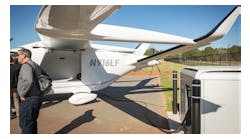Envision a future of flight in which new, community-friendly and cost-effective aircraft transport people and goods in both rural environments and urban centers. The concept of advanced air mobility — also known as AAM or urban air mobility — is emerging, rapidly transitioning from an ambitious vision to an operational reality.
AAM integrates emerging aircraft with the latest developments in electrification, fuels and automation to connect people and goods within and around cities and to and from rural areas.
Given recent advancements in electric propulsion, autonomous flight systems and electric vertical takeoff and landing (eVTOL) technologies, AAM is more feasible and economically viable. This paradigm shift empowers traditional aviation stakeholders to position themselves as innovators, expand market reach, attract new customer segments and stay ahead in an evolving landscape.
As this emerging sector continues its upward trajectory, airport operators and managers must pay close attention to the evolving landscape — especially when addressing unique weather-related challenges. From ensuring safety and planning infrastructure to boosting operational efficiency, complying with regulations, managing risks, and improving the customer experience, all deliver a myriad of compelling reasons for leveraging accurate weather awareness — both in real time and forecast.
Our Evolution Toward Advanced Air Mobility
The rapid emergence of AAM drives a meaningful transformation in the aviation sector, with numerous signals indicating that AAM is reaching a level of maturity beyond just conceptual or technology demonstration ideas.
First, traditional aircraft manufacturers like Airbus, Boeing and others have recently acquired stakes in companies building eVTOL aircraft, although no such aircraft is yet certified to fly anywhere in the U.S. or Europe. Original equipment manufacturers (OEMs) are also developing eVTOL aircraft designs to enable greener and quieter flights.
Airport operators are also positioning themselves for AAM’s emergence, with groups like Ferrovial building dedicated subsidiaries focused in vertiport infrastructure. Additionally, established air traffic management (ATM) firms are making acquisitions to build — as recently announced by Thales and Astra UTM — and bolster their capabilities in areas like uncrewed traffic management (UTM) and urban air mobility corridors.
The aviation industry is heavily regulated, and AAM should be no exception. Developing a framework that accounts for air traffic management rules and ensures the safety of passengers and the public, while accommodating the unique characteristics of drones and eVTOLs, is a complex task. Consequently, collaboration among airport managers, operators, aviation stakeholders, regulatory bodies, governments and communities is crucial. Leading eVTOL aircraft developers hope for commercial Federal Aviation Administration (FAA) certification starting in 2025 and a competitive air taxi market in at least one location by 2028.
The race to capture a share of this potentially lucrative market signals that AAM is operationally ready to take its first tangible steps. Accordingly, airports must recognize this shift and start planning for the implications.
Emerging eVTOL Aircraft and Drone Use Cases and Weather Criticality
One of the initial advanced air mobility applications for airport operators is air taxi services that transport passengers between airports and city centers. This “last-mile” connectivity can provide airports with a competitive advantage, enhancing the traveler experience while opening new revenue streams. Time-sensitive logistics and air cargo deliveries offer another significant opportunity for airport service expansion but remain secondary, among other factors.
Despite these promising applications, the viability and efficiency of AAM operations are intrinsically tied to environmental factors, especially weather conditions. While specific drone and eVTOL aircraft applications like mapping, inspection or filming may tolerate delays due to adverse meteorological events, more mission-critical applications — moving passengers, emergency services, and heavier cargo — demand precise and reliable weather data to ensure safety and effectiveness.
Weather-critical passenger transport and heavy cargo operations require highly accurate meteorological information to mitigate risks and enable consistent, disruption-free service levels. Adopting robust weather intelligence will be crucial as airports explore these revenue opportunities.
Unique Weather Challenges for Vertiports
Some of you might be thinking, “My airport already uses aviation weather management systems to ensure the safety and efficiency of operations.” While that is true for most modern airports, vertiports — the lifeblood of AAM operations — present unique weather challenges that differ significantly from traditional airport concerns.
Traditional airport weather sensing and monitoring systems are designed to address factors like wind shear, runway visibility and precipitation accumulation. Unfortunately, many of these systems may not sufficiently capture the hyperlocal meteorological phenomena that eVTOLs and vertiports will inevitably face (especially in urban environments).
Around the world, low-altitude weather is challenging. Wind gusts, turbulence and vortices caused by the surrounding built infrastructure pose significant risks during critical phases like takeoff and approach maneuvers. Icing on propellers and surfaces due to temperature and humidity variations can compromise aircraft performance, while temperature extremes are a vital concern with eVTOLs, dramatically impacting the battery range. Finally, fluctuations in visibility and cloud ceiling heights create additional hazards for these novel aircrafts.
These micro-climate effects are exacerbated by the relatively low altitudes and tailored designs of eVTOL aircraft compared to traditional airplanes or helicopters. In this evolving aviation landscape, how can airport operators and managers avoid operational impacts like personnel exposure, equipment damage, increased delays and reduced utilization and flight turnaround? By adopting a new mindset and embracing technological solutions tailored explicitly for the burgeoning AAM environment.
Assessing Vertiport Viability and Ensuring Operational Readiness
To navigate this new terrain successfully, airport operators need to account for weather factors across two critical phases: the assessment and operational phases.
1. Assessment phase: As potential vertiport locations are evaluated, leveraging historical data, high-resolution modeling and localized sensing campaigns becomes essential for understanding predominant local- and micro-scale climate patterns. Assessment phase insights enable informed decisions on vertiport site selection, network design, approach path planning and the overall business viability of AAM services.
While simpler at airports than in urban city centers due to open spaces and lack of surrounding tall buildings, this phase helps maximize the return on investment, which is only less than a one-digit percentage of the capital expenditure of a vertiport setting.
2. Operational phase: Once vertiports are established, deploying hyperlocal sensor networks and integrating high-resolution forecasting data into operational workflows is paramount. Automated weather monitoring systems can continuously evaluate weather constraints at individual vertiports and along flight corridors, ensuring efficient flight planning, traffic and fleet management, and resource optimization in real time.
Coordination with air traffic management systems and other stakeholders is also vital during this phase to maintain a cohesive, safety-focused operating environment that accounts for all relevant meteorological factors.
As AAM inches closer to reality, airport operators cannot simply extrapolate weather risks from conventional operations. Instead, they must adapt to the intricacies of AAM-specific weather phenomena to effectively balance necessary safety with the operational efficiency that moves the industry forward.
The Benefits of Early Adoption and Proactive Vertiport Planning
By prioritizing hyper-local weather intelligence from the outset, airport operators can unlock several key advantages as AAM services take flight:
• Maximizing operational safety and reliability: Robust weather monitoring enables informed decision-making, mitigating risks from adverse conditions that could impact passenger safety or damage sensitive cargo.
• Optimizing resource utilization and revenue potential: Accurate early assessment empowers airport decision-makers to recognize problems as early as possible and move to the operational phase more quickly, increasing aircraft utilization, staff productivity and profitability by minimizing weather-related impacts.
• Enabling efficient flight planning, traffic, and fleet management: Integrating weather data with flight planning tools and traffic management systems optimizes routing, scheduling and capacity utilization.
While integrating AAM services may seem daunting, airport operators have a unique opportunity to accelerate their operational readiness. Early insight into vertiport site feasibility, coupled with robust regulatory oversight and existing aviation infrastructure, translates into a smoother transition compared to new entrants building vertiports from the ground up.
AAM: The Next Phase of Flight
Airport operators and managers navigating the AAM landscape should internalize three key points:
1. The weather risks they have experienced in traditional operations may not represent those faced by these novel aircrafts and vertiports. A cautionary approach is advisable.
2. Investing in new sensing equipment and weather intelligence capabilities, tailored to AAM’s unique challenges, will be necessary to bridge potential gaps.
3. Leveraging their highly regulated and well-designed facilities can allow them to bypass certain assessment phases and focus on operational integration more swiftly.
The role of hyperlocal weather intelligence in enabling safe, efficient and profitable operations cannot be overstated as advanced air mobility continues its upward trajectory. By being proactive in their weather-focused planning and fostering collaborative partnerships with solution providers, airport operators can help catalyze this transformative new mode of air transportation and logistics.


